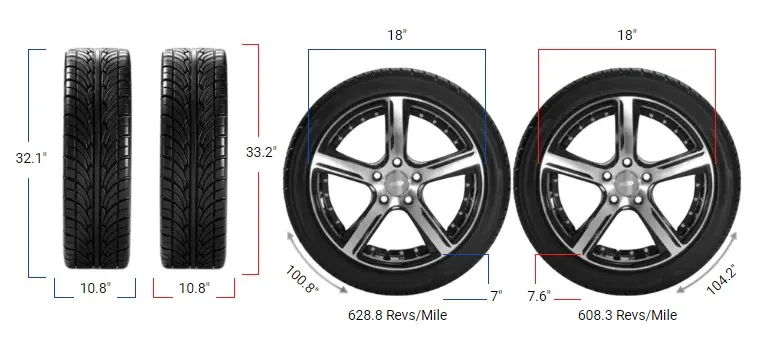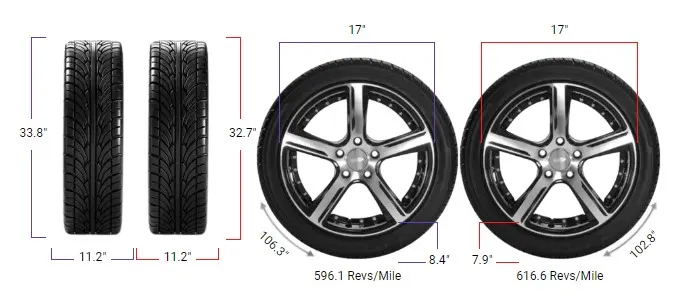Tire Size 245/75r17 vs 235/80r17
 Switching from a 245/75r17 to a 235/80r17 tire involves opting for a slightly narrower and taller tire. While there are benefits like improved ride comfort, there are also drawbacks such as reduced traction and aesthetic changes.
Switching from a 245/75r17 to a 235/80r17 tire involves opting for a slightly narrower and taller tire. While there are benefits like improved ride comfort, there are also drawbacks such as reduced traction and aesthetic changes.
- The 235/80R17 offers a slightly larger diameter for improved ground clearance.
- A narrower width can enhance fuel efficiency.
- The increased sidewall height may provide better comfort on uneven terrain.
- The larger circumference can improve stability at higher speeds.
- A reduction in width may affect traction in certain conditions.
- The 235 tire may offer a more cushioned ride on rough surfaces.

Fitment Guide
In this case, the diameter difference is 1.1%, which is within the acceptable range. This means the interchange is recommended and should not require significant adaptations.
However, it’s always wise to check for adequate clearance to prevent any potential rubbing or fitment issues.
On-Road Impact
Changing tire sizes can significantly influence your daily driving experience. Here’s what to expect when you’re on the road:
Gas Mileage
Switching to a narrower tire like the 235/80r17 can improve gas mileage. The reduced width leads to lower rolling resistance, which can make your vehicle more fuel-efficient, especially during city driving where stop-and-go traffic is common.
Ride Comfort
The 235/80r17 has a taller sidewall by 0.17 inches. This provides more cushioning between the wheel and the road, potentially offering a smoother and more comfortable ride.
The increased sidewall height can absorb bumps and vibrations better than a shorter sidewall.

Speedometer Accuracy
A larger tire diameter affects your speedometer readings. For example, when your speedometer reads 20 mph, your actual speed is about 20.21 mph.
This slight overestimation means you could unknowingly drive faster than intended, so it’s important to be mindful of the difference.
Durability & Wear
The 235/80r17 tire, being narrower, may experience even tire wear compared to wider tires. This can lead to longer tire life if maintained properly.
Additionally, the taller sidewall can help protect against potholes and road debris, reducing the risk of damage.
Off-Road Impact
Changing tire sizes also affects how your vehicle handles off the beaten path. Here’s how the switch influences off-road performance:
Ground Clearance
Switching to the 235/80r17 slightly increases ground clearance by 0.33 inches. This can be beneficial when navigating over rocks, logs, or uneven terrain, reducing the risk of undercarriage damage and improving overall off-road capability.

Traction
The narrower 235/80r17 tires provide a smaller contact patch with the ground, which can result in reduced traction on loose surfaces like mud or sand.
This may affect your vehicle’s off-road performance, making it less capable in challenging conditions compared to wider tires.
Vehicle Capability
A larger and taller tire can enhance your vehicle’s ability to handle rough terrain. The increased diameter and taller sidewall offer better support and stability when climbing steep inclines or navigating uneven trails, improving overall vehicle capability both on and off the road.
Aesthetics Look
Switching to the 235/80r17 can give your vehicle a more rugged and taller appearance. The narrower and taller tires can make your vehicle look more capable and off-road ready.
However, some may find the change less aggressive compared to wider tires, affecting the overall aesthetic appeal based on personal preference.
245/75r17 vs 235/80r17
This table compares the key features of tire sizes 245/75R17 and 235/80R17.
| Feature | 245/75R17 | 235/80R17 | Difference |
|---|---|---|---|
| Diameter inches (mm) | 30.47 (773.9) | 31.8 (807.8) | 1.14 (28.9) 3.7% |
| Width inches (mm) | 9.65 (245) | 9.25 (235) | -0.39 (-10) -4.1% |
| Circumference inches (mm) | 95.72 (2431.28) | 99.91 (2537.78) | 4.19 (106.5) 4.4% |
| Sidewall Height inches (mm) | 7.23 (183.75) | 7.4 (188) | 0.17 (4.25) 2.3% |
| Revolutions per mile (km) | 661.93 (411.31) | 634.15 (394.04) | -27.78 (-17.24) -4.2% |
| Speedo Reading | 20 mph (32.19 km/h) | 20.21 mph (32.53 km/h) | +0.21 mph |
Difference Between 245/75R17 and 235/80R17
The main difference is width; the 245/75R17 tire is 0.39 inches (10 mm) wider than the 235/80R17 tire, providing more road contact.
Can I Use 235/80R17 Instead of 245/75R17?
Yes, you can use a 235/80R17 tire instead of a 245/75R17. The diameter difference is only 1.1%, which is within the recommended 3% difference, but you may notice slight changes in handling.
How Much Taller Is a 235/80R17 Tire Than a 245/75R17?
The 235/80R17 tire is 0.33 inches (8.5 mm) taller than the 245/75R17, representing a 1.1% increase in diameter.
How Much Wider is a 245/75R17 Tire Than a 235/80R17?
The 245/75R17 tire is 0.39 inches (10 mm) wider than the 235/80R17, providing a 4.1% increase in width for better traction.
Our Observation
Switching from 245/75r17 to 235/80r17 offers a mix of benefits and drawbacks. On the positive side, the narrower tires can improve fuel efficiency and provide a smoother ride due to the taller sidewalls.
The increased ground clearance is advantageous for off-road adventures, reducing the risk of undercarriage damage. However, the reduced traction from the narrower tires can impact both on-road handling and off-road performance.
The slight difference in speedometer accuracy is mostly negligible for everyday driving but worth noting. Additionally, the aesthetic change to a taller and narrower profile may not appeal to everyone.
Overall, for drivers prioritizing comfort and fuel economy with occasional off-road use, the switch can be beneficial. However, those needing maximum traction and a more aggressive look might prefer to stick with the original tire size.



